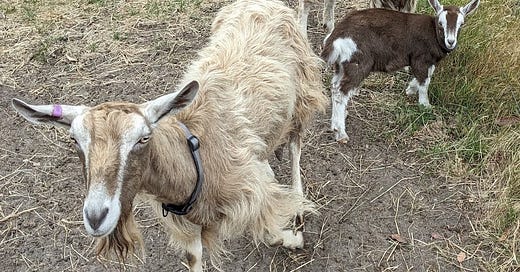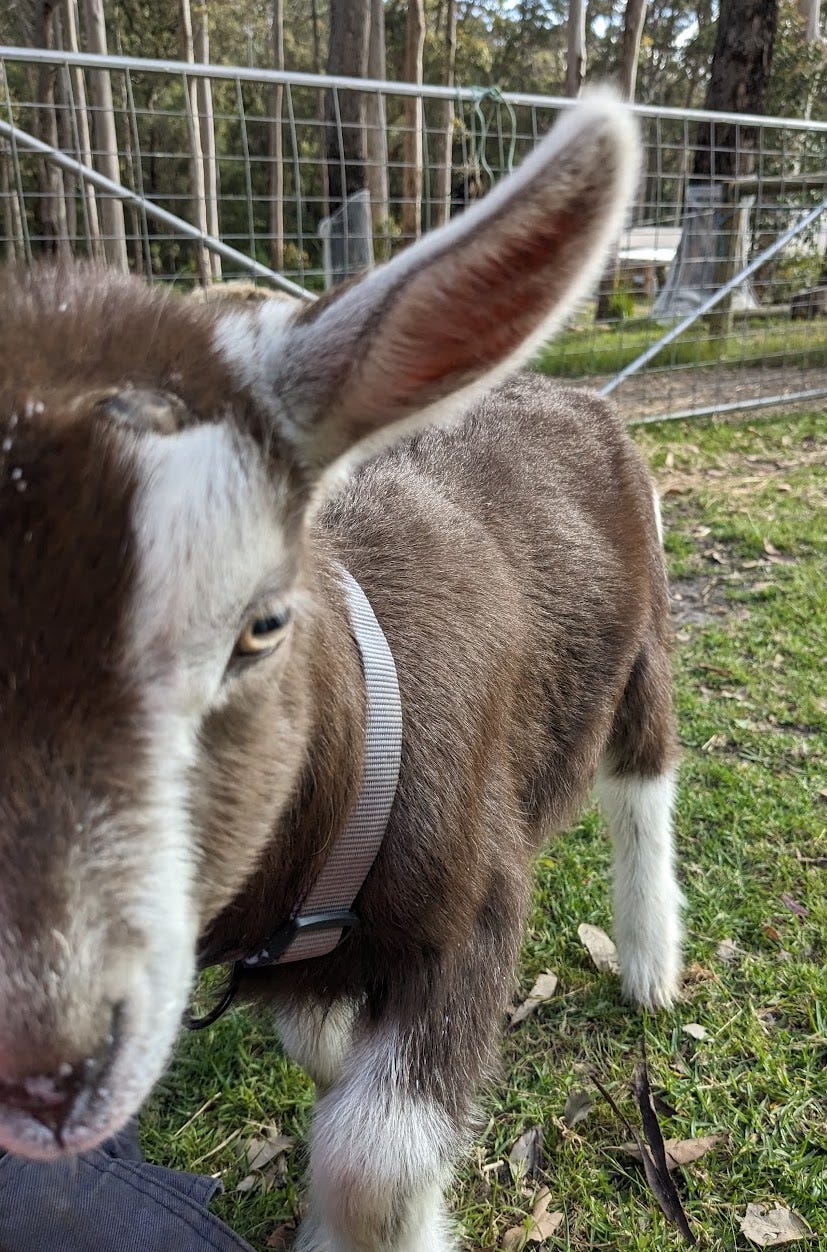Sitting down on the low step, I lean my head against Sesame’s flank as she munches her bucket of feed. Her belly rumbles as she eats; I both hear and feel the rumble. I take one of her teats in each hand and begin the rhythmic squeezing. The milk flows. So ordinary. So miraculous.
Sesame is my new goat. She’s very scruffy, a bit pushy and somewhat cantakerous. In another word, adorable. I picked her up a couple of weeks ago, from the same stud I bought Cinnamon and the ill-fated Nutmeg from a few months ago. My original plan, when I got Cinnamon and Nutmeg, was that I would milk Nutmeg after she kidded. Her kidding was a disaster. Nutmeg and two of her three kids died. I was left with one orphan buck kid, Ashcroft, and the non-pregnant doe Cinnamon. For days after Nutmeg’s death, Cinnamon bleated forlornly. I could hardly blame her; it must have felt like her friend had buggered off and left her kid behind. Which while not an accurate reflection of how it happened, does describe the end result.
If I was a patient, sensible type of person, I would have licked my wounds, continued to bottle feed Ashcroft and waited until next autumn to find a boyfriend for Cinnamon, so she would kid next spring and I could then milk her. Turns out I’m neither patient nor sensible. I rang the breeders and arranged to pick up a doe in milk. Sesame had kidded a couple of weeks prior but her kid had been taken off her and she had been machine milked twice a day since then. Buying Sesame enabled me to get back on track with my original plan, to some extent at least. Albeit without Nutmeg.
After a five hour ride in the horse float, I put Sesame in the paddock with Cinnamon and Ashcroft and left them to get to know each other. A couple of hours later, I took Sesame into the shed and tried milking her for the first time. Rob and I between us extracted a litre of milk from her. It took us about an hour and Sesame took a dim view to standing still for so long, even with a bucket of food. It’s not strictly accurate to say she stood still for much of that time at all. She moved around. She wandered. She protested. My hands ached so much I wondered how on earth I would do this. And why I was bothering.
The next morning, I took Cinnamon and Ashcroft into the shed as well, thinking they would help Sesame calm down. Cinnamon quickly ate her food and proceeded to wreak havoc. She jumped up at the partitions that divide the shed into supposedly goat-proof sections, proving in the process the misnomer in goat-proof as a descriptor of said partitions. Cinnamon succeeded in opening the sliding metal door and let herself and Ashcroft out to explore the wide world. Sesame decided it would be much more interesting to follow the others than stay with me. I discovered it’s very hard to convince a goat to do something when the goat has decided it rather wouldn’t. I had managed to get some milk but Sesame’s udder was far from empty. Disgruntled, I decided that would have to wait for the afternoon, at which time I would definitely leave Cinnamon and Ashcroft in the main paddock. Things did go a little smoother that afternoon, but it was certainly neither smooth nor easy. The next morning, my hands were so achy that Rob had to milk.
Surely it would get easier!
It took a few days for the twice a day routine to settle. But settle it most definitely has. We have a smooth rhythm. I open the paddock gate and clip a lead on Sesame’s collar. She waits for me just outside the gate while I put feed buckets down for Cinnamon and Ashcroft, then we walk up to the shed together. Cinnamon and Ashcroft stay in the paddock. Sesame stands and eats her bucket of feed as I sit beside her and quickly milk her out. The odd thing is that I initially thought I would drop the milking down to once a day, but I love it so much that, for now at least, I’ll stick to twice a day. Bookends on my days.
It’s hard to explain the pure joy it gives me. Hard to explain because I don’t fully understand it myself. There’s something magical about the whole process. Pure alchemy.
One morning, it rained as I was milking. Steady thrumming on the shed’s unlined iron roof. Water running in the gutter and downpipes. Sesame lifted her head, startled at the noises. I spoke quietly to her. “It’s okay girl. It’s just the rain. We’re warm and dry here.” She put her head back in her feed bucket. I kept milking, white froth forming as the milk squirted.
Every milking is a bit of a race between us. Sesame will only stand still so long - I don’t have a head bale or crush for her; she simply stands and eats to be milked. I can only milk so fast. Ideally, I milk her out before she finishes eating, but it’s a close run contest. She decides when she’s done eating and it isn’t always when she’s licked the bucket clean. When she calls time, she walks to the door and waits for me to open it. On a couple of occasions, I have convinced her to come back and stand while I get the last bit of milk. But it’s better if I milk faster and get the job done while she still eats. Then I wait until she is ready to move. My hands are getting stronger, my technique improving. I can milk her out in well under ten minutes now. She gives about two litres of milk, twice a day. That’s a lot of milk. Ashcroft gets about half of it, drinking from a bucket after I take Sesame back to the paddock.
I strain the milk and put it in the fridge. I have it in my tea and on my morning muesli. I’ve made yoghurt (runny, but delicious), feta (firm, also delicious), and cheddar cheese (ripening as I type, hopefully delicious), and have plans for more cheesemaking, more types of cheese. It is so much easier to go to the shop and buy milk and cheese, but there is something about doing this that speaks deeply to me. It’s a simple pleasure. Perhaps it’s my dairy farming ancestry. Perhaps it’s deeper than that. A friend describes milking as a coming together of husbandry, trust and respect, from one to the other. Perhaps that’s it.
See you outside,
Jill





Beautiful description of a very satisfying and productive daily ritual. Look forward to the cheese stories.